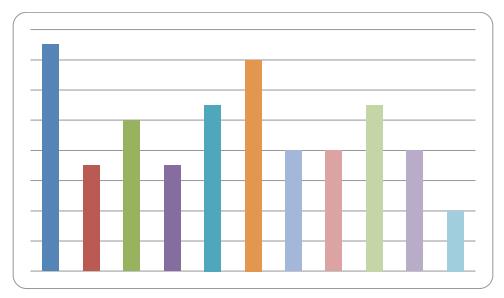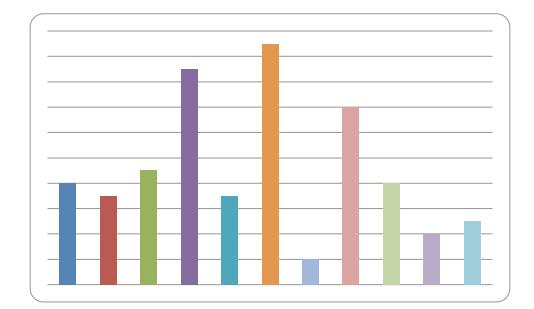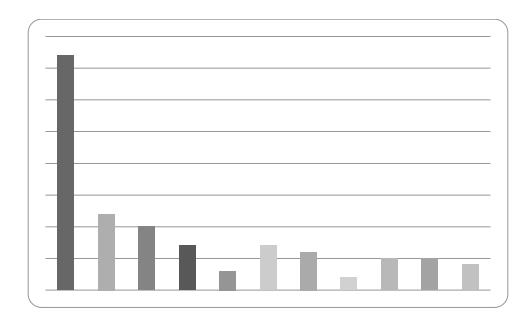Abstract
In recent years, computerization has gone increasingly stronger and to recover pupils with different disabilities, helping them to create optimal conditions for living and working. It was appeared, in this sense, numerous computer programs dedicated to people with mental, sensory, motor or other disabilities. Unfortunately, very few teachers are those who have heard about these programs and, especially, know how to use them in direct work with the student in difficulty. Based on these facts, the present article aims to identify the teachers' attitude towards computer penetration in special education. To achieve this goal, we conducted a scientific research, part of European project much broader, applying a questionnaire with over than 75 items on a sample of 185 students who are preparing for future teaching career. The research results are extremely interesting and prove that most research subjects have a positive attitude to the problematic NTIC using in special education, considering that it facilitates the scholar and social integration of people with disabilities. On the other hand, very few respondents who have heard of various computer programs for pupils with SEN and even fewer are those who use them in concrete situations. In authors’ opinion, the training of teachers and students in using new technology in special education or acquisition of the software for therapy of different types of disabilities become very necessary.
Keywords: Inclusive educationnew technologyspecial educational needs
1. Introduction
Profound transformations from political, economic, social, cultural or demographic viewpoint
affect entire society, no matter of social status or geographical area where its members live. People with
disabilities are no exception and the progress of science or technology, but mist of all, of "mentality"
affect their lives significantly. To meet the needs that facing these people were promoted a series of social
policies which aim, inter alia, to ensure total and active participation in the community life, assisting
people in difficulty to lead their lives in function of their own intentions, prevent or minimize the risk of
deficiencies or their consequences, prevention of social barriers that not allowed people with disabilities
to express it social role, to avoid any form of discrimination against the disabled etc. (Gherguţ, 2005, p.
13). At implementing of these policies is invited to attend the entire community, even if we are talking
about state institutions or private ones, or about “normal” individuals or with different disabilities.
According to the cited author (2005, pp. 23-24), the main direction of action for the implementation of
social policies for persons with disabilities include: legislative measures to promote their rights, change of
attitude by the active involvement of all interested parties, providing services that promote independent
existence, helping families where are living persons with disabilities, create different public and private
structures that support these people, ensuring adequate job training according with their wishes,
promoting a positive and correct image in media, free access to education etc. This creates favorable
premises for an inclusive society in which every person should be able to harness the full potential it has,
benefiting from a proper and equal opportunity to succeed.
Education - as a subsystem of social life - has a special role in building an inclusive society.
According to Gherguţ (2005, p. 13), the main directions of action to fulfill this purpose are:
Schools would be better to include all children - with and without disabilities - in the process of learningby promoting inclusive education;
=Promote early intervention in rehabilitation and education of children with disabilities;
=Minimizing the effects of stereotypes regarding persons with disabilities;
=Providing material resources to educate children with disabilities, based on their real needs.
By implementing these directions at national and international level, we can create favorable
conditions for the promotion of a fundamental principle in a modern society
they belong or their health. On the other hand, the school's mission should be to adapt to each individual
particularities and specific needs, creating in this way a "unity in diversity". It is absolutely natural for
people to be different and the role of education - as a process – and of the the school - as a instrument - is
precisely to lead them to a level which ensures equal opportunities for all to succeed in life. In this way,
could be respected the integrationist philosophy principles, according to which everyone should have an
education accordance with their need.
In terms of teaching, one of the most effective strategies that can be implemented customized
education to each student represents "Instruction Assisted by Computers". This means the use of
multimedia technologies in teaching / learning / assessment, with the aim of providing the information
and made accessible it to the learning possibilities of each student. Among the advantages of ICT, we can
remember (Blândul, 2014):
=a discipline of thought and precision increasing mental operations;
=an early acquisition of general concepts and hypothetical-deductive rationales;
=learning how to implement a heuristic processes;
=a deadlock assimilation techniques.
=an increased motivation for learning;
=a faster transition from concrete to formal operations.
In the educational context, the main functions of ICT are as follows (Blândul, 2014):
=a content presentation;
=Keeping an interactive learning environment;
=a creation of conditions for learning simulators;
=a presentation of educational games;
=a creation of new opportunities for evaluation and obtain feedback;
=an individualization of education;
=providing a database for students and teachers.
In Romania, the issue of ICT was initially viewed with excitement, but then with reserve due to
socio-economic conditions, the reduce number of computers, inadequate teacher training in the field and
its impact on students. It requires awareness of all teachers regarding the importance of ICT in education,
training specialists to create different informatics programs in certain curricular topics, progressively
equipping of schools with new technology, organizing experimental research, redefining the role of
teachers etc. ICT can also significantly contribute to the rehabilitation and educating of students with
disabilities. So for example, we can mention a number of computer programs for people with hearing and
/ or voice disorders, visual impairment, learning difficulties, physical disability etc. (Rutherford, 2016).
But it raises a question mark on the level in which teachers who teach for students with disabilities are
able to use new technology intended for these people. Often, teachers in Romania have computer skills
that are confined to use basic programs included with Word, but do not know how to use educational
software more complex and addressed to various people with disabilities. We believe that from the
perspective of a modern and inclusive learning system, formation of such computer skills become
essential for teachers who want to work with both students - with disabilities and those without such
problems.
2. The Research
2.1 The Objectives
Starting from the previous paragraphs, the main purpose of the present research was the
identification of teachers' skills in using ICT in education for students with disabilities or their availability
to do so. The specific objectives of the research were:
in using ICT in special education,
addressed to different categories of disabilities and
educational software for pupils with SEN. We believe that, in this way, we can have a complete and
complex vision of how teachers are ready and willing to use ICT in special education from Romania.
2.2 The Sample
The sample of research consisted of 105 people (N=105), all teachers from pre-university
mainstream/inclusive schools in Bihor county, Romania. The sample was made up of the following
categories: school stage – 48 (45.7%) primary school teachers and 57 (54.3%) secondary school teachers
(including upper-secondary as well); gender – 29 (27.6%) males and 76 (72.4%) females; qualifications –
12 (11.4%) upper-secondary school graduates, 77 (73.3%) BA graduates, and 16 (15.2%) teachers with
Master’s or PhD degrees; school subjects taught – 60 (57.1%) teach subjects in the fields of humanities
and science, and 45 (42.9%) teach subjects related to technology. The simple random sampling procedure
was used for choosing the people of the sample, which represents approximately 22% of the active
teaching staff of Bihor county, Romania. This research has been conducted within a larger, European
research, which had 1261 respondents from 12 countries, with a minimum sample requested from
Romania of 100. The sample of 105 is representative only for Bihor county, Romania.
2.3 The Methodology
The research instrument was a questionnaire consisting 76 multiple choice items altogether. In the
first part (11 items) factual data about the subjects were requested, as well as data about how often they
use ICT in their teaching activity. In the second part, made up of 65 scale-type items – 11 scales, with 1
meaning “Never/Not at all” and 11 “Very much/Very often” –, the respondents were asked to self-assess
the extent to which they know and use ICT in special education, in general, as well as broken down for
different categories of disabilities (intellectual, sensory, motor skills disorders etc.). The questionnaire
was prepared by educationalists from the Polytechnic Institute of Guarda, Portugal and was sent to the
University of Oradea, Romania, to be administered in Romania with a view to support scientifically a
European project, called „Teaching and Learning in Special Education using ICT” – TELESEICT, within
the Erasmus + Programme, KA2 component. The qualitative analysis of data was performed by
calculating the statistical frequency of the answers provided by the respondents.
2.4 The Results
The results are presented in the following pictures.

The results presented in Figure
about the role of ICT in the education of students with SEN is extremely large and relatively balanced on
the whole scale of possible options. As example, 15.2% of respondents opted negative extreme of the
scale ("1"), 14.3% of them are positioned in the middle ("6") and 9.5% choose the positive area of the
scale ("9"). The large diversity of responses expressed, in fact, the variety of teachers’ training in
computer science, so there are people who can not use the new technology and people who know how to
do this very well. We consider it is very important that all providers of continues training to offer in their
packages of courses some information about the use of ICT in education, thereby contributing to
increasing the rate of “informatics literacy".

The results shown in Figure
17.1% opted to "4", 19% for "6" and 14.3% for "8". The central tendency of the responses indicate
acceptable levels in litter based on the training of surveyed teachers regarding ICT applications in various
categories of disabilities. This means that teachers have average knowledge about the use of ICT for
pupils with mental, sensory or physical disorders. The situation is a positive one, because, if it is
necessary, teachers can more easily specialize in one area of ICT for special education.

The results presented in Figure
research have just minimum general knowledge on how to design different educational software for
students with disabilities. The results are somewhat normal, because teachers who teach different topics
(languages, mathematics, science etc.) do not have a professional obligation to know the way how are
designed various educational software. However, possession of such skills is beneficial for a teacher,
since it can help him to better understand the functioning of an educational software and, being able to
use it more successful. We believe, therefore, that ICT training should include elements of designing
educational software, thereby increasing both performance and use interest regarding the discussed topic.
3. Discussions and Conclusion
A first important aspect to be highlighted refers to the importance of ICT in the education and
therapy of pupils with SEN, as demonstrated by specialized research and educational actors empirical
observations. Thus, Glaeser (2015, pp. 1-5) points to the role of new technology in the recovery of
students with ADHD and, especially, the educational software which can stimulate these students' ability
to focus attention. In a study with a sample of 657 students between the ages of 11 and 15 years, Durrant
& Hook & McNaney & Williams & Smith & Stockman & Olivier (2014, pp. 34-47) underline the role
digital photographs plays in helping children with behaviour problems to express their emotions, as well
as in the interpersonal communication in inclusive classes. Zikl & Bartošová & Víšková & Havlíčková &
Kučírková & Navrátilová & Zetková (2014, pp. 915-122) describe an educational software for dyslexia
correction which aims at increasing reading/writing speed and cutting down mistakes by using special
fonts, of various types and colours, adjusted to the needs of these children. Finally, Alves & Schmidt &
Carthcat & Hostins (2015, pp. 3081-3086) present the JAWS software for Windows, which, using a voice
synthesizer, can read out texts for people with visual impairments. Based on the results of these studies,
we believe it is extremely important for all specialists in the field of special education to be aware on the
need of ICT use in education and recovery pupils with SEN, namely to advise them to effectively use the
various applications for this purpose. Of course, technology can not replace the traditional therapeutic
strategies, but they can successfully complete them, so that children with disabilities benefit from the best
conditions for recovery (Rutherford, 2016).
One of the most effective ways to achieve this objective is the initial and continuous training of
teachers in ICT applied in special education. However, the acquisition of the ICT competences required
in special education should take place in parallel with that of those other methodological and psycho-
pedagogical competences teachers need. This fact is supported by the results of studies carried out in this
field, which prove that the effective use of ICT in special education increases when the new technology is
integrated with traditional teaching activities. For example, in order to increase the chances of integrating
students with SEN in mainstream schools, Humphrey & Lendrum & Barlow & Wigelsworth & Squires
(2013, pp. 1210-1225) developed an educational intervention program based on three components:
involvement of parents in the teaching process, development of students' transferable competences and
the use of educational software adjusted to the students needs. The sample of the study consisted of 4.758
students from 323 schools in England. The results showed that 72.5% of the students included in the
programme improved significantly their school attainment and managed to integrate properly in
mainstream education. The results of the current study demonstrate that most of the respondents believe
in the effective use of ICT in special education, even though they have poor knowledge in this respect.
Thus, these teachers need professional training in this area, but this thing should be done along with their
specialised, psycho-pedagogical and methodolological training so that they benefit from an overall vision
on the way the teaching process should take place.
As a conclusion, we can say that most teachers understand the importance and have at least
general knowledge on the use of ICT in education. This is proven by the fact that new technology is
frequently used in daily teaching activities. However, not all teachers know how to use ICT in special
education. Moreover, there are very few who know specific software to design for different students with
disabilities. Therefore, any providers of initial and continuing training should include in their educational
offer some content regarding the design and use of ICT applications in special education, programs that
complement therapeutic traditional strategies and contributing to a better rehabilitation and social or
professional integration of children / adults in need.
References
- Alves, A.G., Schmidt, A.E., Carthcat,K., Hostins, R. (2015). Exploring Technological Innovation towards
- Inclusive Education: Building Digital Games – An Interdisciplinary Challenge. Procedia - Social and Behavioral Sciences, 174, 3081-3086.
- Blândul, V., (2014) – Basisof Formal Education, ProUniversitaria Publishing House, Bucharest,
- Romania.
- Durrant, A., Hook, J., McNaney, R., Williams, K.,Smith, T., Stockman, T., Olivier, P. (2014).
- Interpersonal expression in the special educational needs classroom: An experience-centred design case study. International Journal of Child-Computer Interaction, 2 (1), 34-47.
- Gherguţ, A., (2005) – Synthesis of Special Psycho-pedagogy, Polirom Publishing House, Iaşi, Romania. Glaeser, L., (2015). Breaking through: Using educational technology for children with special needs.
- Education and Information Technologies, pp 1-5, 2015. Doi:10.1007/s10639-015-9378-4 Humphrey, N., Lendrum, A., Barlow, A., Wigelsworth, M., Squires, G. (2013). Achievement for All: Improving psychosocial outcomes for students with special educational needs and disabilities. Research in Developmental Disabilities, 34(4), 1210-1225.
- Rutherford, G., (2016), Questioning special needs: Supporting student teachers,in Troubling and transforming understandings of human worth, in Teaching and Teacher Education, Volume 56, p. 127-137.
- Zikl, P., Bartošová, I.K., Víšková, K.J., Havlíčková, K., Kučírková,A., Navrátilová, J., Zetková, B.(2015). The Possibilities of ICT Use for Compensation of Difficulties with Reading in Pupils with Dyslexia.Procedia - Social and Behavioral Sciences, 176, 915-922.
Copyright information

This work is licensed under a Creative Commons Attribution-NonCommercial-NoDerivatives 4.0 International License.
About this article
Publication Date
25 May 2017
Article Doi
eBook ISBN
978-1-80296-022-8
Publisher
Future Academy
Volume
23
Print ISBN (optional)
-
Edition Number
1st Edition
Pages
1-2032
Subjects
Educational strategies, educational policy, organization of education, management of education, teacher, teacher training
Cite this article as:
Blândul, V. C. (2017). The Importance Of New Technology In Rehabilitation Of Pupils With Special Needs. In E. Soare, & C. Langa (Eds.), Education Facing Contemporary World Issues, vol 23. European Proceedings of Social and Behavioural Sciences (pp. 644-651). Future Academy. https://doi.org/10.15405/epsbs.2017.05.02.79

